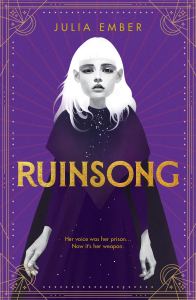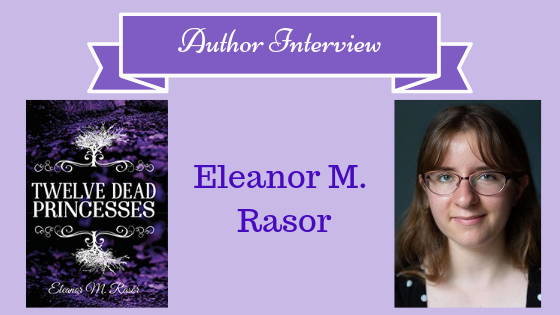
Twelve Dead Princesses is a dark retelling of the classic fairy tale “The Twelve Dancing Princesses.” Shortly before Larka, soon-to-be-queen of Belmarros, comes of age, she and her eleven sisters fall ill. On the brink of death, they are saved by Sol, a tattooed stranger with powerful magic, and find themselves owing a debt. Sol, however, is more than meets the eye and he wants the princesses to dance for him at night in his otherworldly kingdom. As they dance, Larka finds it increasingly difficult to balance their secret visits, her responsibilities as future queen, and her growing attracting to Sol…
Today I’ve got something new for the blog: an author interview! I’ve got twelve questions with Eleanor M. Rasor, the author of the new release Twelve Dead Princesses. I’m really excited to chat with her today because 1) her book is a fantastically unique, gothic retelling of one of my favorite fairy tales and 2)…she’s my sister! Keep reading to hear about her writing process, inspirations, and what brand of shoe a death god might wear!

Describe your book in five words.
Death. Gods. Romance. Dancing. Gothic.

What was the inspiration for Twelve Dead Princesses? How did you come up with your unique spin on a classic fairytale?
When I was a kid, I adored fairy tales and used to read them constantly. One that I used to read over and over was The Twelve Dancing Princess which, for anyone unfamiliar with it, is about a king with twelve daughters who go to a mysterious ball every night and dance their shoes to pieces. The story never properly explains what this ball is or why they’re dancing there, and I always felt unsatisfied by it. I’ve read a ton of retellings of the story and I wanted to write my own. At some point I thought to myself, what if the land they’re dancing is in the underworld? And so the idea for my book was born.

What was the writing process like? Specifically, tell us about the program you were a part of that allowed a teenager to publish a fantasy book?
I started writing Twelve Dead Princesses during my sophomore year of high school as a short story for my creative writing class, but it quickly spiraled out of control. I tried to do it for 2016 NaNoWriMo but didn’t finish and I just kept writing it in between other projects. Eventually I decided to apply to a program called Young Emerging Authors, run by an amazing nonprofit called the Telling Room, where four teenagers are selected to write, edit, and publish a book over the course of a year. I got in, and I finished writing and revising my book with the help of a really great mentor. The program forced me to write much quicker–it took me almost three years to write the first draft and about ten months to edit it–and I learned a lot about writing and editing over the course of this book.

I know the final version of your book is pretty different from the initial concept. How did your story change during writing/revisions?
Oh boy, it changed a lot. My first draft was 127,000 words long (for reference my final draft was about 90,000 words) and had the points of view of the three eldest sisters. When I stepped back and looked at the book, though, I realized that it was way too long. Since two of the points of view weren’t adding much to the book, just spiraling out into increasingly random plot lines, I ended up deleting them (and one of my favorite side characters, sadly). The finished version has a single point of view, focuses much more on the retelling aspect, and also has a completely different ending.

What was your favorite part or character to write?
My favorite part to write was probably anything set in the underworld. It’s a totally different world than the living one, with different rules and inhabitants, and I liked slowly unspooling the mystery of it at the same time the main characters are learning.

Tell us something about your book that isn’t in the description!
This is really an extremely minor detail, but the god of death never wears shoes. I couldn’t decide what kind of shoes he would wear, so he’s just barefoot during the whole book.

Who do you think Twelve Dead Princesses would appeal to?
I think it’ll appeal to fans of fairy tale retellings with a slightly more gothic air. Also anyone who enjoys the types of romance with a little more darkness, like Wicked Saints by Emily Duncan or the Winternight Trilogy by Katherine Arden.

Retellings seem to be a staple of YA books. Why do you think retellings keep resonating with people?
I think it’s because fairy tales are so classic and well-known that retellings always hit certain beats, but the author also has to add something new in order to make it theirs. It’s always fun to see how someone else retells and interprets a story.

Obviously, no writer exists in a void and we all have our influences. What books/authors have influenced you?
Diana Wynne Jones, Leigh Bardugo, and Juliet Mariller are three authors that I read at a young and impressionable age so they left me with a love of magical houses, villains, and books with lots of siblings.

Twelve Dead Princesses takes place in an original fantasy world. How did you go about constructing the world?
Rather haphazardly, to be honest. I plunged into writing it with pretty much only the ideas that it was a fairytale retelling and that there would be a pantheon of gods who were all dead except for one. Things started to develop more during revisions. I started with questions–what are the politics like in this country? How did the loss of their gods affect the culture? What kind of magic remains and who uses it?–and tried to work the answers into the book.

What’s next for you?
I’m currently working on the rough draft of a new novel featuring a living house, a lot of messy family dynamics, and dragons. After that, who knows? I have a ton of other ideas bouncing around. But mostly, college!

Describe your book in one meme!
Here’s one featuring most of the main characters!


I’m so happy I could share this interview with you all! I think Twelve Dead Princesses is super cool (and, fair warning, I’m prepared not to shut up about it for quite a while). If you enjoyed this interview, you can buy Twelve Dead Princesses from the Telling Room’s online store here and add it on Goodreads here. (Bonus: buying it from their store means proceeds go to fund more young writers programs!)


Eleanor M. Rasor has been writing stories filled with things such as magic, dragons, and girls with swords for almost as long as she can remember. When not writing, she can be found reading, swimming in the ocean, riding her bike, or over-analyzing action movies. A Mainer at heart, she plans on attending Mount Holyoke College in the fall, where she hopes to keep writing.
Freepik flower attribution




















